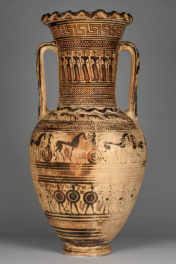
Young Men with dompas, White City, Jabavu, Soweto, November 1972, David Goldblatt (South African, born 1930). Gelatin silver print, 9 x 9 in. (22.9 x 22.9 cm). The J. Paul Getty Museum, Los Angeles. Purchased with funds provided by the Photographs Council. © David Goldblatt
The Getty Museum has acquired eight photographs by David Goldblatt (b. 1930), one of South Africa’s most important photographers. His candid photographs of racially divided neighborhoods and cities during apartheid are enduring historical documents, influencing a generation of photographers through images that provide a clear vision of the social and economic dichotomies that shaped South Africa under apartheid and continue to shape it today.
Timothy Potts, the director of the Museum, shared this about Goldblatt’s work:
The disturbing power of Goldblatt’s work is as great today as it was during the apartheid era he portrays. This is testament not only to the stark and shocking nature of his subject matter but also to the carefully structured composition and formal beauty of his images. The addition of these works represents another important step in the growth of the Getty’s international photography collection, and we are especially grateful to our Photographs Council whose generous support has made this acquisition possible.
The eight gelatin silver prints the Museum acquired represent some of Goldblatt’s earliest and best-known projects from the 1960s to the 1980s, and all have been in his personal collection since they were created. They focus on poor communities in Johannesburg and Soweto and affluent towns such as Boksburg. A bridal party, mining employees, a Methodist congregation, and leisure pursuits of the middle class are among his subjects.

Dutch Reformed Church, Quellerina, Johannesburg, Gauteng (Transvaal), November 3, 1986, David Goldblatt (South African, born 1930). Gelatin silver print, 34.8 x 28 cm (13 11/16 x 11 in.). The J. Paul Getty Museum, Los Angeles. Purchased with funds provided by the Photographs Council, © David Goldblatt

A Bridal Party, Orlando East, Soweto, 1970, David Goldblatt (South African, born 1930). Gelatin silver print, 24.5 x 24.7 cm (9 5/8 x 9 3/4 in.). The J. Paul Getty Museum, Los Angeles. Purchased with funds provided by the Photographs Council, © David Goldblatt
Goldblatt began working in photography in 1948, the same year the National Party came to power in South Africa, bringing with it sweeping laws that created the apartheid state. Avoiding the sensational and violent scenes that often found their way into international media, Goldblatt’s photographs documented everyday occurrences in black and white communities, revealing the banalities of a complex and unjust society. An example is the following image, which features Saturday afternoon lawn work in Sunward Park, a prosperous neighborhood in Boksburg.

Saturday afternoon in Sunward park, April 1979, David Goldblatt (South African, born 1930). Gelatin silver print, 38.1 x 38.4 cm (15 x 15 1/8 in.). The J. Paul Getty Museum, Los Angeles. Purchased with funds provided by the Photographs Council, © David Goldblatt
In the last five decades Goldblatt has produced sixteen books of his work and has been featured in many gallery and museum exhibitions. He is also the recipient of numerous awards, including the Hasselblad Foundation International Award (2006) and the Henri Cartier-Bresson Award (2009). In the past year, Goldblatt’s work has been featured in three major exhibitions: Rise and Fall of Apartheid: Photography and the Bureaucracy of Everyday Life at ICA in New York, Everything Was Moving: Photography from the 60s and 70s at the Barbican, and South Africa in Apartheid and After at SFMOMA.
This acquisition was made with funds provided by the Getty Museum’s Photographs Council. Founded in 2005, the Photographs Council is a dynamic group of supporters who actively assist in the expansion of the Museum’s collection.




Congratulation on this purchase. I look forward to seeing a major show of African photography at the Getty one day.